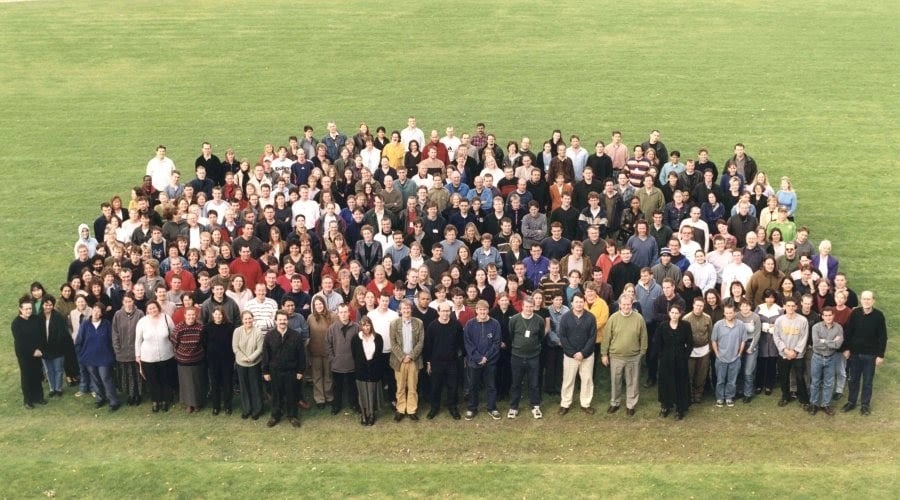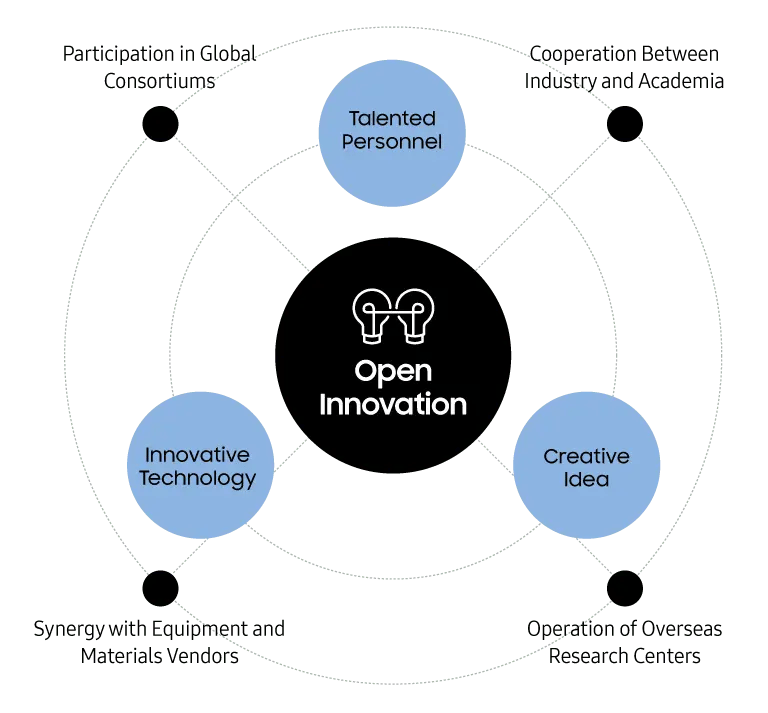When it comes to innovation in business, there are a lot of terms and definitions you need to keep in mind.
Open innovation, crowdsourcing, co-creation: Even for the experts, keeping track of these concepts can be a challenge. Read enough articles and definitions, and you’ll soon find yourself with a headache for your troubles.
But fear not - we’re here to break it all down for you.
First, though, let’s start with a few simple definitions.
Open innovation defined
Open innovation is a distributed, participatory approach to innovation. This concept recognizes that useful knowledge exists in a number of different places, including both within and outside a business.
In practice, open innovation involves businesses and organizations gathering ideas from external sources as well as internal ones. It’s a great way to boost company innovation, and lets established businesses break through the secrecy and silo mentality of traditional R&D.

Since being defined by Henry Chesbrough in the early 2000s, the concept of open innovation has changed the way businesses approach the development of ideas. Now, plenty of companies are looking beyond their office walls for their next big breakthrough.
As Chesbrough notes, the flows of information have changed in the modern world, and innovation practices need to keep up with these changes: “Useful knowledge today is widely distributed, and no company, no matter how capable or big, can innovate effectively on its own.”
This makes is essential for companies to invite a wider range of viewpoints when searching for solutions to tough problems, either through innovation challenges, research partnerships between startups and corporate firms, or public events like hackathons.
Open innovation benefits
Compared to traditional business R&D, open innovation has some amazing benefits:
- Diverse and innovative ideas: By inviting and encouraging a wider range of expertise and experience to contribute to problem-solving, open innovation allows companies to benefit from a greater diversity of innovative ideas.
- Overcoming silos: Traditional product development can often be a siloed activity, with company departments (or even teams within the same department) being hesitant to collaborate or share information. Open innovation helps break through this reluctance.
- Lower innovation costs: Expertise is expensive, and developing ideas for new products and services can be a costly exercise. By enticing others outside of the business to contribute their skills, open innovation can lower the costs of ideation.
- Faster product development: By involving a wider pool of talent, open innovation allows companies to take products from proof of concept through to pilot and testing a lot faster. That’s because having many contributors speeds up the problem solving process.
- Greater product visibility: Collaborating beyond the business isn’t just a great way to boost innovation - it also boosts the visibility of the finished product. That’s because there’s an attentive group of contributors already interested in the final result.
- Investor interest: For emerging startups, open innovation is an excellent way to drum up investor interest. Inviting others outside the business to participate in the innovation process helps a startup demonstrate its market presence and get attention.
Open innovation considerations
Open innovation is a great technique, but it also requires businesses to balance the following considerations:
- Resource commitments: Open innovation takes a lot of effort to get right. Companies need to define the problem at hand, source the right expertise, and manage the collaboration in a way that gives contributors clear and dependable information.
- Intellectual property and commercial information: Businesses seeking input from external parties need to share a certain level of baseline information. This makes open innovation less suited to commercially sensitive projects involving intellectual property.
- Culture shift: Open innovation requires a shift in management culture. Businesses need to be open to sharing information and expertise outside the office walls, and this is often challenging for those used to operating within secretive silos.
- Clear rules: The best results from open innovation come when all parties are crystal clear on the problem definition, the process for collaboration, and the expected results. Without this clarity, open innovation can lead to confusion and inconsistent outcomes.
Crowdsourcing defined
Now, let’s take a look at the second of our innovation techniques: crowdsourcing.
Put simply, crowdsourcing involves companies or organizations seeking knowledge, goods, or services from a large body of people.
Companies can use crowdsourcing to invite people to submit ideas in response to online requests made either through social media, smartphone apps, or dedicated crowdsourcing platforms. These people can be paid freelancers, but often they are simply volunteers or fans.
In practice, crowdsourcing is an incredibly diverse practice, involving things from online restaurant reviews using sites like Yelp and Zomato, all the way through to distributed scientific research like the Human Genome Project.

Crowdsourcing is a way of looking beyond a business or organization’s internal capacity for ideation, and turning the question over to a wider group of thinkers. This offers businesses with a way to complete complex tasks faster, and to access expertise they don’t have internally.
One key detail, though: don’t get crowdsourcing mixed up with crowdfunding. Crowdfunding sites like Kickstarter and Patreon offer ways for individuals and businesses to seek funding and support for an emerging project. This isn’t the same thing.
Crowdsourcing benefits
Like open innovation, crowdsourcing involves some great benefits for companies:
- Valuable curveball ideas: Crowdsourcing exposes businesses to unexpected solutions to tough problems. These ‘curveball’ ideas can be extremely valuable, and can help a business to overcome status quo thinking.
- Marketing buzz: By gathering attention to a specific problem or opportunity, crowdsourcing helps build interest in ideas for new products and services. This gives businesses an existing audience ready for the release of the final product.
- Greater diversity of thought: Small and emerging businesses don’t have a huge pool of internal talent to draw from. By solving problems with the power of the crowd, these businesses can access a greater diversity of thought and experience.
- Reduced management burden: Overseeing product development and innovation teams involves a certain level of management burden. With crowdsourcing, businesses can get access to the same great ideas, but without the day-to-day management burden.
- Faster problem-solving: As with open innovation, crowdsourcing allows companies and organizations to solve complex problems a lot faster. This is particularly well-suited to software coding projects, such as open-source products like Mozilla’s Firefox browser.
Crowdsourcing considerations
Just like with open innovation, crowdsourcing also involves a set of considerations businesses and organizations need to keep in mind:
- Creating clear incentives: Crowdsourcing gets the best results when there are clear incentives for fans and experts to contribute their time and effort in responding to a problem. Companies should offer reward or recognition for ideas and information.
- Commercial confidentiality: Just like open innovation, crowdsourcing involves sharing information with participants. This means crowdsourcing isn’t well-suited for projects involving sensitive or commercially confidential information.
- Less control over ideation process: Crowdsourcing product ideation means sharing the process with a wider group of people. This requires a more hands-off approach from businesses, and the ability to trust a group of fans and customers.
Co-creation defined
Last in our trio of innovation techniques is co-creation.
Co-creation is when businesses include outsiders in the ideation and development process. Typically, this involves working alongside private or public individuals (usually customers or hard-core fans) to develop ideas for new products, services, and systems.
Businesses can invite outside parties to contribute via social media platforms (for example, the ‘My Starbucks Idea’ Twitter account, or through using a dedicated co-creation portal (for example, the DeWalt Insight Community).

A great example of co-creation in practice is DHL’s innovation centers, where the logistics company invites experts and hard-core fans to collaborate in solving complex problems like remote package delivery and voyage sequencing.
In many ways, co-creation is the modern equivalent of old-fashioned research and development techniques, such as focus groups, surveys, and polls. Co-creation gives companies the chance to work alongside die-hard customers and understand how to give them more of what they want.
Co-creation benefits
By allowing companies and organizations to work closely with their customers and fans, co-creation offers the following benefits:
- Building a community of fans and users: Co-creation lets businesses cultivate a community of die-hard fans and customers. By inviting people to collaborate in the innovation process, co-creation builds a closer relationship between fans and brands.
- Matching products with demand: Co-creation offers businesses deep insights into what their fans and customers are looking for, and enables them to develop products to match these demands. This leads to stronger sales and brand reputation.
- Accessing fresh thinking: As with open innovation and crowdsourcing, co-creation allows businesses to access fresh ideas for new products and services. By working alongside fans and customers, companies can access diverse and unexpected ideas.
- Identifying ‘blue ocean’ opportunities: By working so closely with fans, businesses can develop a detailed picture of the consumer experience. This helps companies identify ‘blue ocean’ gaps in the market (for example, Canon’s move into home printing).
Co-creation considerations
When co-creation goes well, the results can completely transform business. However, companies need to bear the following considerations in mind:
- Public relations risks: Because a company is inviting external parties to participate, it has less control over what these parties do and say. This can expose a company to PR risks, such as negative commentary on its internal workings.
- Ideas should match core criteria: Co-creation works best when participants have a clear set of criteria to work with. If companies don’t offer these criteria, co-creation can lead to inconsistent ideas that don’t match the core project brief.
- Management requirements: Co-creation involves working closely with groups of fans and customers to develop new ideas. Compared to open innovation or crowdsourcing, this requires a higher management burden, costing a lot of time and money.
What makes these three techniques different?
Whether a business is looking for great ideas for new products, ways to involve a wider range of expertise in its internal systems, or build a community of fans, each of these three innovation techniques is a great way to approach problem-solving.
But what sets these techniques apart from each other, exactly?
It comes down to the following factors:
- Degree of openness: Some innovation techniques are more radically open and transparent than others. For example, co-creation is more collaborative than crowdsourcing, and involves sharing a greater depth of information.
- Management requirements: Each of these techniques requires close management. Even so, some techniques are more hands-on than others. For example, co-creation involves closer oversight than open innovation or crowdsourcing.
- Prescriptive vs. permissive: Open innovation gives participants a lot of freedom to contribute their ideas, whereas co-creation and crowdsourcing work best when participants have a prescribed problem or opportunity to respond or react to.
- Variety of ideas: Open innovation comes in a lot of different shapes and sizes, with fans and experts contributing their ideas on their own terms. In contrast, crowdsourcing and co-creation work best when companies offer a clear problem description.
Considering which innovation technique to use involves balancing these factors and matching the demands of the project against the different options.
Which innovation technique should you use?
To help you decide which innovation technique to use for a particular project, we’ve outlined a series of key questions you should work through.
- Commercial sensitivity and intellectual property:
- How sensitive is the subject of the project?
- Would a fan or customer need access to commercially sensitive information to contribute their great ideas?
- Does the project involve the exchange of intellectual property?
- Management considerations:
- Do you have the resources necessary to manage a potentially time-consuming innovation project?
- Do you have a clear project brief or problem description?
- What is the likely timescale of the project?
- Innovation goals:
- What are your goals with the innovation project?
- Are you seeking a defined niche group of expert knowledge, or is your goal to build a dedicated community of fans?
- How important is it to generate marketing buzz in the project?
Your answers to these questions will tell you which of these innovation techniques are right for the job. For example, if you don’t want to commit to a resource-heavy co-creation project, you could look at crowdsourcing customer suggestions instead.
On the other hand, if the project involves valuable intellectual property or commercially sensitive information, traditional internal R&D is probably the best way to go.
If you intend to kick off an open innovation or crowdsourcing project, consider a dedicated platform like Innocentive, or develop a bespoke innovation portal like Unilever, DeWalt and other companies. For crowdsourcing, social media platforms like Twitter or Facebook will be enough.
Innovation in practice: A few helpful examples
Sometimes the best way to illustrate a concept is to look at a few real-world examples. Here, we’ll cover a handful of great examples of open innovation, crowdsourcing, and co-creation, and show you how these all work in practice.
Samsung: Better products through open innovation
As one of the world’s leading tech giants, Samsung relies on valuable ideas for new products and services to stay on top. One of the ways Samsung does this is through open innovation.
That’s why Samsung participates in thirteen industry consortiums around the world, helping to source cutting-edge expertise and ideas for new products and services. Samsung also has close relationships with a range of universities through academic partnerships.

Source: Samsung
This diverse approach to open innovation illustrates the fact that valuable ideas can come from anywhere. By partnering with academics and other experts, Samsung helps to secure its commercial advantage and anticipate the next big movement in the market.
Google: Everyday crowdsourcing
As one of the biggest and most influential companies in the world, Google has built its success in part through an ongoing commitment to crowdsourcing.
Google realises that helpful information is widely distributed around the world. That’s why the company incentivizes its users to contribute this information to make its products and services more accurate, timely, and useful.
A great example of the company’s commitment to crowdsourcing is Google Maps. This product includes a baseline commitment to crowdsourcing, feeding information from each user back into the system to make sure that voyage information is current.
In fact, this crowdsourcing feature is now so widely-used, most people probably don’t even think of it as crowdsourcing!
Lego: Making co-creation cool
Lastly, Lego’s Ideas platform is a cool and colourful example of co-creation at work.

As one of the world’s leading toy outfits, Lego has a huge community of dedicated fans ready to contribute great ideas for new sets. To make the most of this community, Lego established its Ideas platform, giving fans the chance to compete for their proposals to be selected.
Since establishing this platform over ten years ago, over a million Lego fans have submitted their ideas for new sets. The platform has not only been a commercial success for Lego, but has also helped strengthen the company’s global fanbase and earn Lego some great press.
Know which technique to use, and start innovating!
Open innovation, crowdsourcing, and co-creation are all excellent innovation techniques. Used well, they can form a core part of any business’s innovation strategy.
With these techniques, you can speed up idea generation, kick off your next suite of innovation projects, and harness the power of your online community of fans and customers.
Before you start using these techniques, though, you need to know what you’re dealing with. That’s why we’ve put together this article to help unpack these innovation concepts, explain the differences between them, and illustrate how they work in practice.
Whether you’re looking for a way to break through the status quo with open innovation, harness the power of the crowd with crowdsourcing, or find valuable new ideas with co-creation, these techniques have a lot to offer.
So, be sure to check these innovation techniques out and see how they might work for you.




